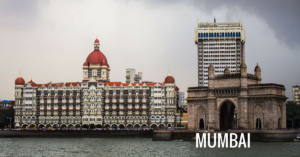According to New World Wealth, India’s financial capital Mumbai, home to 45,000 millionaires and 28 billionaires, is the wealthiest city in the country with total wealth of $820 billion.
About Mumbai :
Mumbai is the capital city of the Indian state of Maharashtra. It is the most populous city in India and the ninth most populous agglomeration in the world, with an estimated city population of 18.4 million.
- Along with the neighbouring regions of theMumbai Metropolitan Region, it is one of the most populous urban regions in the world and the seсond most populous metropolitan area in India, with a population of 20.7 million as of 2011.
- Mumbai lies on thewest coast of India and has a deep natural harbour. In 2009, Mumbai was named an alpha world city. It is also the wealthiest city in India, and has the highest GDP of any city in South, West, or Central Asia. Mumbai has the highest number of billionaires and millionaires among all cities in India.

- The seven islands that came to constitute Mumbai were home to communities of fishing colonies. For centuries, the islands were under the control of successive indigenous empires before being ceded to the Portuguese and subsequently to the British East India Company when in 1661 King Charles II married the Portuguese Catherine of Braganza, and as part of her dowry Charles received the ports of Tangier and seven islands of Bombay.
- During the mid-18th century, Bombay was reshaped by the Hornby Vellard project, which undertook reclamation of the area between the seven islands from the sea. Along with construction of major roads and railways, the reclamation project, completed in 1845, transformed Bombay into a major seaport on the Arabian Sea.
- Bombay in the 19th century was characterised by economic and educational development. During the early 20th century it became a strong base for theIndian independence movement. Upon India’s independence in 1947 the city was incorporated into Bombay State. In 1960, following the Samyukta Maharashtra movement, a new state of Maharashtra was created with Bombay as the capital.
- Mumbai is the financial, commercial and entertainment capital of India. It is also one of the world’s top ten centres of commerce in terms of global financial flow, generating 6.16% of India’s GDP and accounting for 25% of industrial output, 70% of maritime trade in India (Mumbai Port Trust and JNPT), and 70% of capital transactions to India’s economy.
- The city houses important financial institutions such as the Reserve Bank of India, the Bombay Stock Exchange, the National Stock Exchange of India, the SEBI and the corporate headquarters of numerous Indian companies and multinational corporations.
- It is also home to some of India’s premier scientific and nuclear institutes likeBARC, NPCL, IREL, TIFR, AERB, AECI, and the Department of Atomic Energy. The city also houses India’s Hindi (Bollywood) and Marathi film and television Mumbai’s business opportunities, as well as its potential to offer a higher standard of living, attract migrants from all over India, making the city a melting pot of many communities and cultures.
Mumbai’s Economy :
Mumbai is India’s largest city (by population) and is the financial and commercial capital of the country as it generates 6.16% of the total GDP.
- It serves as an economic hub of India, contributing 10% of factory employment, 25% of industrial output, 33% of income tax collections, 60% of customs duty collections, 20% of central excise tax collections, 40% of India’s foreign trade and Rs.4,000 crore(US$590 million) in corporate taxes.
- Although Mumbai had prominently figured as the hub of economic activity of India in the 1990s, the Mumbai Metropolitan Region is presently witnessing a reduction in its contribution to India’s GDP.
- As of October 2015, Mumbai’s GDP is $278 billion (from 2014)and its per-capita (PPP) income in 2009 was Rs.486,000(US$7,200), which is almost three times the national average.
- Its nominal per capita income is Rs.125,000 (US$1,900), (US$2,094). Many of India’s numerous conglomerates (including Larsen & Toubro, State Bank of India (SBI), Life Insurance Corporation of India (LIC), Tata Group, Godrej and Reliance) and five of the Fortune Global 500 companies are based in Mumbai.
- This is facilitated by the presence of theReserve Bank of India (RBI), the Bombay Stock Exchange (BSE), the National Stock Exchange of India(NSE), and financial sector regulators such as the Securities and Exchange Board of India (SEBI).
- Until the 1970s, Mumbai owed its prosperity largely to textile mills and the seaport, but the local economy has since then diversified to include finance, engineering, diamond-polishing, health care and information technology.
The key sectors contributing to the city’s economy are: finance, gems & jewellery, leather processing, IT and ITES, textiles, and entertainment. Nariman Point and Bandra Kurla Complex (BKC) are Mumbai’s major financial centres. Despite competition from Bangalore, Hyderabad and Pune,
- Mumbai has carved a niche for itself in the information technology industry. The Santacruz Electronic Export Processing Zone (SEEPZ) and the International Infotech Park (Navi Mumbai) offer excellent facilities to IT companies.
- State and central government employees make up a large percentage of the city’s workforce. Mumbai also has a large unskilled and semi-skilled self-employed population, who primarily earn their livelihood as hawkers, taxi drivers, mechanics and other suchblue collar professions. The port and shipping industry is well established, with Mumbai Portbeing one of the oldest and most significant ports in India.
- Dharavi, in central Mumbai, has an increasingly large recycling industry, processing recyclable waste from other parts of the city; the district has an estimated 15,000 single-room factories.
- Mumbai has been ranked sixth among top ten global cities on the billionaire count, 48th on the Worldwide Centres of Commerce Index 2008, seventh in the list of “Top Ten Cities for Billionaires” by Forbes magazine (April 2008), and first in terms of those billionaires’ average wealth.
Other entries :
Top 3 cities | |
| 1 | Mumbai |
| 2 | Delhi |
| 3 | Banglaore |
While Delhi, home to 22,000 millionaires and 18 billionaires has total wealth of USD 450 billion, Bengaluru boasts of a total wealth of USD 320 billion. The city is home to 7,500 millionaires and 8 billionaires.
Other wealthiest cities include,
- Hyderabad (total wealth of USD 310 billion, has 8,200 millionaires, 7 billionaires);
- Kolkata (USD 290 billion, has 8,600 millionaires and 10 billionaires);
- Pune (USD 180 billion, has 3,900 millionaires and 5 billionaires);
- Chennai (USD 150 billion and has 6,200 millionaires and 4 billionaires) and
- Gurgaon (USD 110 billion and home to 3,600 millionaires and 2 billionaires).






